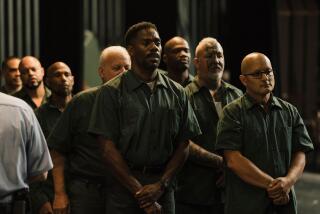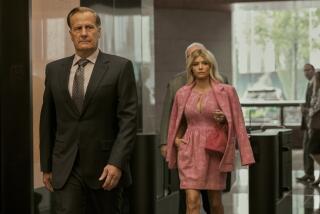Full Houses for ‘The Full Monty’
The resounding box-office success of the low-budget British comedy “The Full Monty” sounds like Hollywood’s version of a fairy tale.
The film--a poignantly comic tale about six unemployed steelworkers in Sheffield, England, who decide to raise money by stripping for a night--is an art-house movie that has transcended that genre and drawn audiences of all ages, genders and moviegoing tastes.
“The Full Monty” is playing to sellout (and unusually vociferous) audiences. This past weekend the film with the obscure title came in fifth at the box office, grossing $2.9 million on only 387 screens, bringing its domestic total to $6 million. Since opening a month ago, the movie is on its way to becoming the most successful independent film of the year. (In Britain it has already taken in about $13 million, topping the box office for three straight weeks, including the weekend of Princess Diana’s funeral.)
What’s behind the phenomenon? What inspires normally staid film audiences to whoop and applaud throughout the movie and even whistle as the sextet of ordinary-looking men work up to their striptease act?
“It’s not like anything that’s been out lately,” said Shari Kraidman, who waited in line for two hours to see the film at a West Hollywood multiplex. “I thought it was really funny, but it also had some sensitivity, too. It was real. You could feel for these guys. It’s not one of those movies people will just see once. As time has gone by, I like it more and more.”
Indeed, the filmmakers were going for a gentle comedy that dealt honestly with the more serious themes of unemployment, relationships, gender politics, self-esteem and trying to make an honest buck.
“So many movies entertain the audience with explosions and outer space and terror,” said Lindsay Law, president of Fox Searchlight Pictures. “They kind of forget the audience loves to enjoy itself. And they love for it to be kind of truthful.”
“The film came at a time when America was frankly tired of the summer blockbuster and was looking to sink its teeth into something more real,” said David Dinerstein, senior vice president of marketing for Fox Searchlight. “It’s the first time we’re seeing a film where men literally bare their souls, amongst other things, and they do it in a genuine way. It’s not a contrived story.”
*
Producer Uberto Pasolini conceived of the idea for the film, chose Simon Beaufoy to write the screenplay and Peter Cattaneo to direct it. He took the idea to Britain’s Channel 4 and Miramax Pictures, but ultimately made a deal with Fox Searchlight.
“This film is not about men strippers,” Pasolini said. “The film tells a story about people who get involved in that, but it’s about bigger issues: unemployment, the loss of self-esteem, the position of men and women in working-class families in Great Britain. The enjoyment of the film relies very much on your identifying with the concerns and problems of the people in this film. . . . I think the American public is appreciating the freshness of the setting and a group of actors who they don’t know. They can believe these people are real.”
Audience members talk about the sociological implications of the film, such as seeing the tables turned on men, who in planning their striptease act, realize what it is like to be treated as sex objects.
“It was fun and makes a statement from a feminist point of view,” said Fay Solloway, who saw the movie Sunday night at a Burbank megaplex. “Men have been laughing at women strippers and feeling free to criticize [women’s bodies]. Now, that’s turned in this movie. These men are not particularly attractive or talented, but they become interesting.”
The charmed existence of the film--which was made for a scant $3.5 million and stars a cast of relative unknowns--began in January 1996, when Pasolini and Fox Searchlight’s Law struck a deal during the Sundance Film Festival to make the movie.
Twelve months later, Sundance festival officials saw it, loved it and arranged a screening for it, even though the deadline had passed for it to be included officially in the festival.
Fox Searchlight executives literally ran all around Park City, Utah, taping up posters letting people know about the impromptu screening, the movie’s “world premiere,” held in the town’s library.
The word of mouth quickly spread from there, assisted by an unusual marketing campaign that featured Monday night test screenings of the film in 10 cities across the country during July and early August, in advance of the film’s Aug. 13 opening.
The film’s marketers also took out ads in those 10 big cities to generate awareness of the movie by capitalizing on its unusual title.
The dated, working-class English expression “the full monty” is loosely translated as “going the whole nine yards” in a strip show, according to Pasolini, who said that the title was a point of contention for filmmakers and studio types.
“We were of two minds about the title,” the producer said. “We did think about changing it to something that would be more readily understandable and not so alien, but we never found something we were happier with. Instead of the title being a weakness for the film, we decided to turn it into a strength. We decided to make the title something for people to discover.”
Two of the film’s co-stars, Robert Carlyle, who starred in “Trainspotting,” and Mark Addy are making the rounds of media outlets and talk shows.
“Stripping works as a kind of metaphor for stripping down to raw emotions and insecurities that we all feel,” said Addy, who played Dave, a 30ish man wrestling with self-esteem issues stemming from his unemployment, marital problems and overweight physique. “We knew we had a good script, but that’s about all we knew. You sort of hope that people will go see it, but you don’t expect them to go in such numbers and enjoy it so much.”
More to Read
Only good movies
Get the Indie Focus newsletter, Mark Olsen's weekly guide to the world of cinema.
You may occasionally receive promotional content from the Los Angeles Times.










